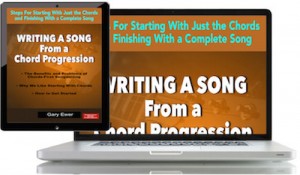Forward motion is a term that refers to the sense of musical energy in a song. In real terms, forward motion is what makes a listener want to keep listening to a song. In other words, the listener wants to believe that as good as the song is at this moment, it’s going to sound even better in a moment or two. That sense of anticipation that a listener feels is created by what we technically call forward motion.
 If you like starting songs by working with a chord progression, you need to read “Writing a Song From a Chord Progression.” It will give you the pros and cons of this songwriting method, and help you create songs that really work!
If you like starting songs by working with a chord progression, you need to read “Writing a Song From a Chord Progression.” It will give you the pros and cons of this songwriting method, and help you create songs that really work!
Songs are a collection of many components: lyrics, melodies, chords, instrumentation, singing style, and so much more. All of those components work in partnership with each other and support each other.
The more successfully those parts support each other, the better the song sounds. In that sense, it is the partnership of parts — not isolated parts themselves — that determines how good a song sounds.
So you might compose a wonderful song melody, but if the chords don’t support it properly, your melody fails. You might create a wonderfully climactic moment in the chorus, but if the vocal style or the instrumentation doesn’t support it, that climactic moment fails.
Forward motion, or musical energy, is hard to discuss because it’s different for every song. In other words, what propels a song forward and makes people want to keep listening is different for every song.
And also, it’s not just a songwriting issue: it’s a production issue as well. So if you want to be sure that you’re writing and then recording something that works from a musical energy point of view, consider these important principles:
- The sense of musical energy you get from a song should (most of the time) increase as a song moves from beginning to end. The rise of musical energy does not need to be glaringly obvious. Most of the time in pop music, the energy build is slight.
- Instrumental choices are a big part of what causes and sustains forward motion. It might be the choice of instrument (adding an extra guitar part in verse 2, for example), but it might also be something as simple as how a guitar is played: finger picking for verse 1, strumming for verse 2. It might also be how high an instrument plays, how busy the drums sound, and so on.
- How the lyric unfolds will help or hinder forward motion. There needs to be a good sense of progression in the story, a nice sense of chronological development in how circumstances are described. Each line of lyric needs to be a logical follower for the line that precedes it. In that regard, it can be a very powerful diagnostic tool to read your lyric from end to beginning, line by line, to see if in fact each line sounds like the logical follower it needs to be.
- The tonic note plays a very important role in how forward motion is perceived. The tonic note represents the key of your song. You should encounter that note more often in a chorus than in a verse. And also, there’s a very subtle sense that in a song verse, a melody is venturing out and away from the tonic chord, while in a song chorus it’s constantly seeking to return to that tonic note.
- Within a song’s section, melodies should generally rise to create musical energy. Rising melodies is one of the most common ways to create musical energy because as a voice moves higher we automatically interpret that increased vocal strain as energy. Over its entire length, any one melody will rise and fall, so what I’m describing is a general pattern of rising as you compare the beginning of any one melody to its end.
These are just five ideas, and there are many more ways that forward motion is created and maintained. You’ll discover more ways as you experiment. In any case, if you find that your own songs are causing you to feel bored, the reason is that forward motion hasn’t been created, and if it has, it hasn’t been sustained.
So the solution to making a song sound suitably energetic is to pull it apart, component by component, and get a good sense of what each one separate component does for the song, and how it modifies over time.
 Written by Gary Ewer. Follow Gary on Twitter
Written by Gary Ewer. Follow Gary on Twitter
 Thousands of songwriters are using “The Essential Secrets of Songwriting” eBook bundle to polish their songwriting technique. Every aspect of how to make a song better is covered. Stop wasting time — take your songwriting technique to a new level TODAY. Ten eBooks, plus a free one: $37 USD (Immediate download).
Thousands of songwriters are using “The Essential Secrets of Songwriting” eBook bundle to polish their songwriting technique. Every aspect of how to make a song better is covered. Stop wasting time — take your songwriting technique to a new level TODAY. Ten eBooks, plus a free one: $37 USD (Immediate download).










